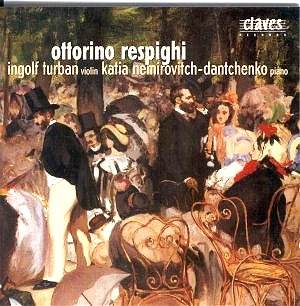It was not long before Bologna learnt that the student
Respighi was a brilliant violinist, violist and pianist. The 1897
Sonata is an early essay by a seventeen year old composer. In this
work Brahms and Schumann are undeniable presences. It lacks the rampantly
intoxicating atmosphere of early Fauré (Piano Quartet No. 1),
Vierne or Cras or the turbulent mastery of John Foulds' Cello Sonata.
All the same this is a work confident in the Brahmsian melos and with
deft imaginative touches in the Adagio and in the mercurial gentlenesss
of the Scherzo - Allegretto (try sampling 1.38 tr. 3).
This disc represents the world premiere of the 1897
sonata and the Six Pieces. The Pieces include a
rather urgent and quick-flowing Aria, a hoarsely amber-toned
Melodia, a rather dour Serenata, a conventionally cosmopolitan
Berceuse oozing commercial sentimentality, a starry and unhurried
Valse caressante and a Leggenda. These sketches show more
personality than the early Sonata as well as an increasing mastery.
I am grateful to note writer Georg-Albrecht Eckle for pointing out that
of the six movements four come from works for, or with, orchestra and
the other two (Melodia and Valse) are from the Six
Pieces for Piano P44, 1904-5. The works are the Aria for
strings and organ (1901), Berceuse for strings P36 (1902), Legend
for violin and strings P38 and the Serenade from Respighi’s first
published opera, Re Enzo P55 (1904).
The 1917 Violin Sonata lacks the modal nature
of the Concerto Gregoriano and in the first of the three movements
carries a Brahmsian impress in many pages. It is a troubled work (try
3.47 et seq. in tr.10). Its power to move asserts itself unequivocally
in the Andante espressivo; extremely impressive. The Passacaglia,
despite its melodramatic Beethovenian 'overture' and some schmaltz along
the way rises to eloquence at 5.20 onwards (tr. 12). It is no wonder
that this work was taken up by Heifetz.
Ingolf Turban has recorded extensively for Claves.
His tone is not unduly sleek, sweet and searching rather than opulent.
Nemirovitch-Dantchenko nicely complements Turban although she is recorded
in a softer focus than her partner. It is not a disagreeable effect
but is certainly noticeable.
This disc, strong on detailing and performance and
intelligent in choice of repertoire is self-recommending to Respighians.
This is a composer still deeply and pleasurably entangled with the Brahmsian
legacy. Only in the 1917 work does he give signs of setting out into
new regions.
Rob Barnett
AVAILABILITY
www.claves.ch
Discovery Records
phone UK 01380 72800
fax UK 01380 722244
info@discovery-records.com


